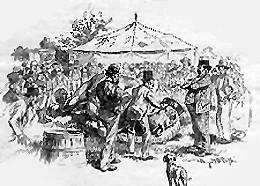Popular Amusements
Many cartoonists used images and metaphors drawn from popular amusements. As shown by the quotations on this page, such references also appeared in speeches and editorials, and pervasive political loyalties crept into all areas of public life, even the zoo.Rural and urban Americans of all ages enjoyed concerts, lectures, and travelling shows. Most towns hosted such performances in an 'opera house,' so named because many citizens feared the moral dangers of having a 'theater.' The sponsors were often local organizations such as Lyceums, fraternal orders, reform groups, and a rapidly growing number of women's clubs. Attendance at educational lectures and concerts, in particular, was a mark of respectable self-improvement.
Theater troupes and circuses travelled the country performing out-of-doors or in tents and rented halls, for audiences of all classes and ethnic groups. Minstrel shows--often performed by white musicians and actors in blackface--remained popular with white audiences, side-by-side with sentimental productions of 'Uncle Tom's Cabin' and other dramatizations of the plight of the slave.
Some sports events, such as bare-knuckle prizefighting, were enjoyed mostly by men. But for both men and women, the 1890s ushered in an emphasis on vigorous exercise, fresh air, and outdoor amusements: see the separate page on the bicycle craze.
![[puma pic]](pumas.gif)
TWO NEW ADDITIONS TO THE PUMA FAMILY NAMED McKINLEY AND BRYAN.
'Bryan,' and 'McKinley' were born at the Central Park Zoo on Friday. They are twin pumas, and are the first baby pumas that have made an appearance at the Zoo in years. They are remarkably small, being barely eight inches in length and three inches tall. Their color is a delicate buff, but down the back of each runs a stripe of brownish black. . .
Director Smith announced that they have been named after the presidential candidates. The elder showed, almost immediately after birth, that it possessed a pleasant voice and agreeeable manners. By early afternoon it had crawled to every part of its cage, had cried to make friends with the keeper, and its voice had often been heard.
'Call it Bryan!' said one of the keepers, and the idea met with instant agreement.
The younger showed a strong aversion to moving about, and persisted in not uttering a sound, and therefore recieved the name of the Canton candidate...
--New York Journal, 13 September, 1896
![[trapeze pic]](trapeze.gif)
Scientific American, 25 January, 1896
I might just as well put up a trapeze on my front lawn and compete with some professional athlete as go out speaking against Bryan. I have to think when I speak. --William McKinley, quoted in Stanley L. Jones, The Presidential Election of 1896.
Bryan's campaign speeches are like a minstrel show. You hear one, you hear them all.
--National Reflector (African-American), 31 October 1896
Cartoons Depicting Popular Amusements
September 13, L.A. Times
September 14, Rocky Mountain News
September 26, Harper's Weekly
November 2, L.A. Times
November 4, L'Abeille de Nouvelle Orleans

